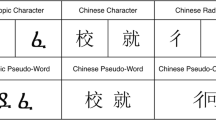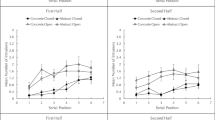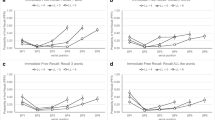Summary
The effectiveness of a part of a stimulus as a retrieval cue for the whole is investigated in two experiments. Stimuli consisting of a series of eight colored dots were presented for 7s. In Experiment 1, the first three dots of a stimulus made up the cue. A structural compatibility between stimulus and cue was shown to enhance recall. Experiment 2 used only the first dot as a cue for the same stimuli as in Experiment 1 in order to control the possible alternative prediction based on Garner's work that the effect was due to a difference in complexity of stimuli, regardless of compatibility with the cue. The compatibility predictions are derived from a model based on a hierarchy principle by Buffart.
Similar content being viewed by others
References
Anderson, J. R. (1978). Arguments concerning representations for mental imagery. Psychological Review, 85, 249–277.
Buffart, H. (1986). Gestalt qualities, memory structure, and minimum principles. In F. Klix & H. Hagendorf (Eds.), Human memory and cognitive capabilities: Symposium in memoriam Hermann Ebbinghaus. Amsterdam, NL: North-Holland.
Buffart, H. (1987). Seven minus two and structural operations. In E. Roskam & J. Suck (Eds.), Progress in mathematical psychology, I. Amsterdam, NL: North-Holland.
Buffart, H., & Geissler, H.-G. (1984). Task-dependent representation of categories and memory-guided inference during classification. In E. Degreef & J. van Buggenhaut (Eds.), Trends in mathematical psychology. Amsterdam, NL: North-Holland.
Buffart, H., and Leeuwenberg, E. (1983). Structural information theory. In H.-G. Geissler, H. F. J. M. Buffart, E. L. J. Leeuwenberg, and V. Sarris (Eds.), Modern issues in perception. Amsterdam, NL: North-Holland.
Buffart, H., Leeuwenberg, E., & Restle, F. (1981). Coding theory of visual pattern completion. Journal of Experimental Psychology: Human Perception and Performance, 7, 241–274.
Buffart, H., Leeuwenberg, E., and Restle, F. (1983). Analysis of ambiguity in visual pattern completion. Journal of Experimental Psychology: Human Perception and Performance, 9, 980–1000.
Collard, R., & Leeuwenberg, E. (1981). Judged temporal order of visual patterns. Canadian Journal of Psychology, 35, 323–329.
Cutting, J., & Proffitt, D. R. (1982). The minimum principle and the perception of absolute, common, and relative motions. Cognitive Psychology, 14, 211–246.
Garner, W. R. (1974). The processing of information and structure. Potomac, MD: Erlbaum.
Geissler, H.-G., & Puffe, M. (1983). The inferential basis of classification: from perceptual to memory representation systems. Part 2: Experiments on discrete feature processing. In H.-G. Geissler, H. F. J. M. Buffart, E. L. J. Leeuwenberg, and V. Sarris (Eds.), Modern issues in perception. Amsterdam, NL: North-Holland.
Greeno, J. G., James, C. T., & Da Polito, F. J. (1971). A cognitive interpretation of negative transfer and forgetting of paired associates. Journal of Verbal Learning and Verbal Behaviour, 10, 331–345.
Hatfield, G. C., & Epstein, W. (1985). The status of the minimum principle in the theoretical analysis of visual perception. Psychological Bulletin, 97, 155–186.
Handel, S., & Todd, P. (1981). Segmentation of sequential patterns. Journal of Experimental Psychology: Human Perception and Performance, 7, 41–55.
Hochberg, J. (1978). Perception (2nd edition). Englewood Cliffs, NJ: Prentice-Hall.
Koffka, K. (1935). Principles of Gestalt psychology. London: Routledge & Kegan Paul.
Leeuwenberg, E. (1969). Quantitative specification of information in sequential patterns. Psychological Review, 76, 216–220.
Leeuwenberg, E. (1971). A perceptual coding language for visual and auditory patterns. American Journal of Psychology, 84, 307–349.
Leeuwenberg, E. (1982). The perception of assimilation and brightness contrast as derived from code theory. Perception & Psychophysics, 32, 345–352.
Leeuwenberg, E., & Boselie, F. (1988). Against the likelihood principle in visual form perception. Psychological Review, 95, 485–491.
Leeuwenberg, E., & Buffart, H. (1983). An outline of coding theory: a summary of related experiments. In H.-G. Geissler, H. F. J. M. Buffart, E. L. J. Leeuwenberg, and V. Sarris (Eds.), Modern issues in perception. Amsterdam, NL: North-Holland.
Leeuwenberg, E., & Buffart, H. (1984). The perception of foreground and background as derived from structural information theory. Acta Psychologica, 55, 249–272.
Marr, D. (1982). Vision. San Francisco: W. H. Freeman & Co.
Massaro, D. W. (1988). Some criticisms of connectionist models of human performance. Journal of Memory and Language, 27, 213–234.
Mellink, H., Buffart, H. (1987). Abstract code network as a model of perceptual memory. Pattern Recognition, 20, 14151.
Mens, L., & Leeuwenberg, E. (1988). Hidden figures are ever present. Journal of Experimental Psychology: Human Perception and Performance, 14, 561–571.
Minsky, M., & Papert, S. (1969). Perceptrons. Cambridge, Mass.: MIT Press.
Palmer, S. E. (1977). Hierarchical structure in perceptual representation. Cognitive Psychology, 9, 441–474.
Palmer, S. E. (1982). Symmetry, transformation, and the structure of perceptual systems. In J. Beck (Ed.), Organization and representation in perception. Hillsdale, NJ: Lawrence Erlbaum Associates.
Pomeranz, J. R., & Kubovy, M. (1986). Simplicity and likelihood principles. In K. Boff, L. Kaufman, & J. Thomas (Eds.), Handbook of perception and human performance, Vol. II. New York: Wiley.
Postman, L., & Underwood, B. J. (1973). Critical issues in interference theory. Memory & Cognition, 1, 19–40.
Restle, F. (1970). Theory of serial pattern learning: Structural trees. Psychological Review, 77, 481–495.
Restle, F. (1973). Serial pattern learning: higher order transitions. Journal of Experimental Psychology, 99, 61–69.
Simon, H. A. (1972). Complexity and the representation of patterned sequences of symbols. Psychological Review, 79, 369–382.
Simon, H. A., & Feigenbaum, E. A. (1964). An information processing theory of some effects of similarity, familiarization, and meaningfulness in verbal learning. Journal of Verbal Learning and Verbal Behavior, 3, 385–396.
Leeuwen, C. C. van (1989a). PDP and Gestalt. An integration? Psychological Research, 50, (this issue).
Leeuwen, C. C. van (1989b). Structural memory and the dynamics of preference. Ph. D. Thesis, Nijmegen.
Leeuwen, C. C. van, Buffart, H. F. J. M., & der Vegt, J. van (1988). Sequence influence on the organization of meaningless serial stimuli: economy after all. Journal of Experimental Psychology: Human Perception and Performance, 14, 481–502.
der Vegt, J. van, Buffart, J., & Leeuwen, C. C. van (1989). The Structural Memory. A network model for human perception of serial objects. Psychological Research, 50, (this issue).
Tuijl, H. van (1975). A new visual illusion: neonlike color spreading and complementary color induction between subjective contours. Acta Psychologica, 39, 441–445.
Tuijl, H. van (1980). Perceptual interpretation of complex line patterns. Journal of Experimental Psychology: Human Perception and Performance, 6, 197–221.
Tuijl, H. van, & Leeuwenberg, E. (1979). Neon color spreading and structural information measures. Perception & Psychophysics, 25, 269–284.
Tuijl, H. van, & Leeuwenberg, E. (1982). Peripheral and central determinants of subjective contour strength. In H.-G. Geissler, P. Petzoldt, H. F. J. M. Buffart, & Y. M. Zabrodin (Eds.), Psychophysical judgement and the process of perception. Amsterdam, NL: North-Holland.
Vitz, P. C., & Todd, T. C. (1967). A model of learning for simple repeating binary patterns. Journal of Experimental Psychology, 75, 108–117.
Author information
Authors and Affiliations
Rights and permissions
About this article
Cite this article
van Leeuwen, C., Buffart, H. Facilitation of retrieval by perceptual structure. Psychol. Res 50, 202–210 (1989). https://doi.org/10.1007/BF00309254
Received:
Issue Date:
DOI: https://doi.org/10.1007/BF00309254




